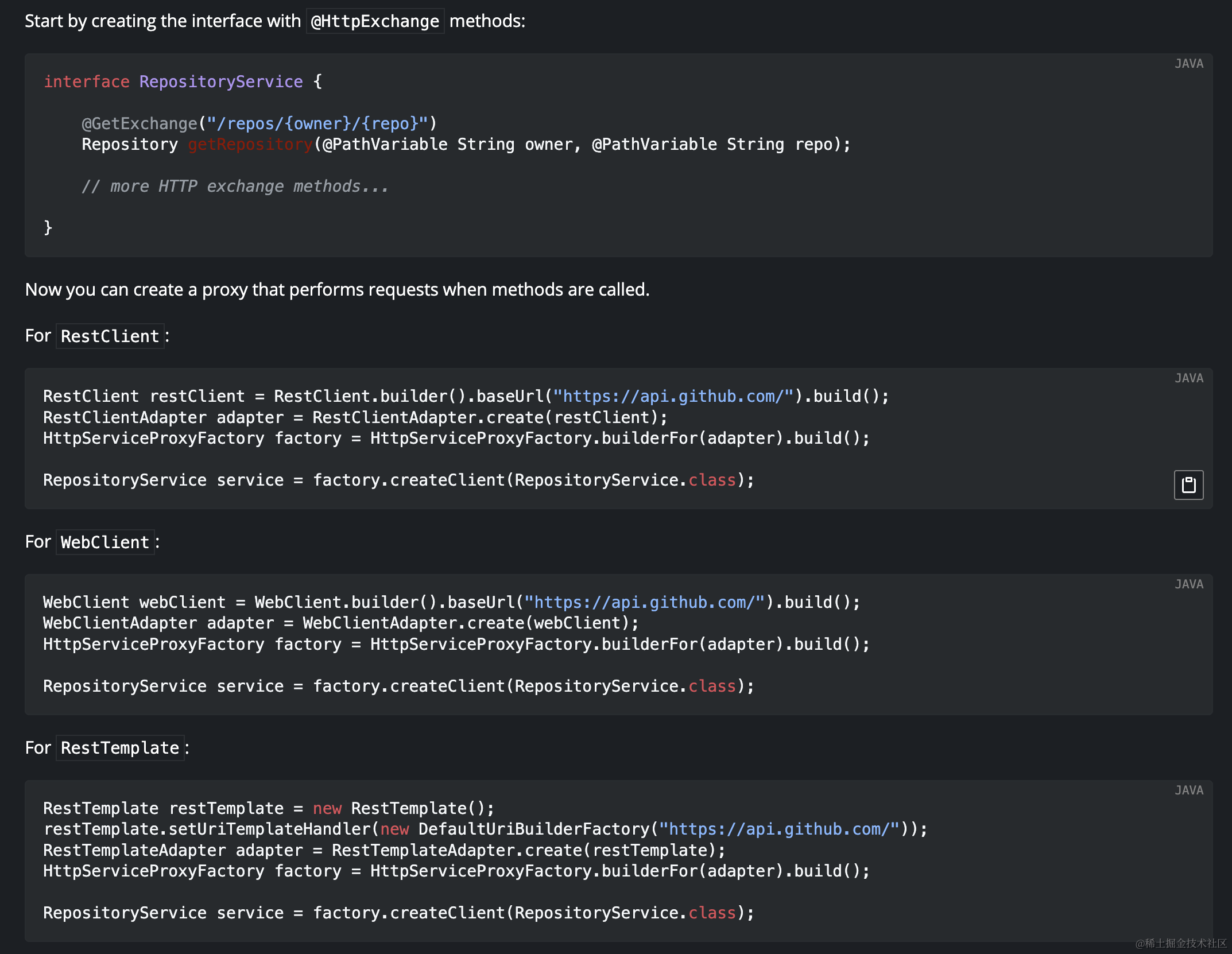个人博客:无奈何杨(wnhyang)
个人语雀:wnhyang
共享语雀:在线知识共享
Github:wnhyang - Overview
官网
REST Clients :: Spring Framework
The Spring Framework provides the following choices for making calls to REST endpoints:
- RestClient - synchronous client with a fluent API.
- WebClient - non-blocking, reactive client with fluent API.
- RestTemplate - synchronous client with template method API.
- HTTP Interface - annotated interface with generated, dynamic proxy implementation.
RestClient
官方描述:RestClient是一个同步HTTP客户端,它提供了一个现代、流畅的API。它提供了对HTTP库的抽象,允许从Java对象到HTTP请求的方便转换,以及从HTTP响应创建对象。
Spring6.1版本新特性。
创建
创建RestClient非常简单,可以使用静态create方法,也可以使用builder创建,其提供了非常丰富的定制化选项,请求工厂、消息转换器、拦截器、默认头、请求初始化器等等,简单易懂。
RestClient defaultClient = RestClient.create();RestClient customClient = RestClient.builder().requestFactory(new HttpComponentsClientHttpRequestFactory()).messageConverters(converters -> converters.add(new MyCustomMessageConverter())).baseUrl("https://example.com").defaultUriVariables(Map.of("variable", "foo")).defaultHeader("My-Header", "Foo").requestInterceptor(myCustomInterceptor).requestInitializer(myCustomInitializer).build();
使用
使用RestClient更为简单,请求URL、Header、Body、相应Response接受、异常处理等等相当丰富简单。
String result = customClient.get().uri("https://example.com/this-url-does-not-exist").retrieve().onStatus((code) -> code.value() / 100 == 4, (request, response) -> {throw new RuntimeException(response.getStatusCode() + " " + response.getHeaders());}).body(String.class);
WebClient
WebClient是一个无阻塞、响应式的客户端,用于执行HTTP请求。它在5.0中引入,提供了RestTemplate的替代方案,支持同步、异步和流式传输场景。
早在Spring5版本中就已经出现,创建方法和RestClient差不多,简单示例如下,其他详细内容可参考官网可Java Doc。
WebClient webClient = WebClient.builder().baseUrl("http://localhost:8081").build();
RestTemplate

相比于上面两位这个更是古老,也正因此更为常见,使用的更多。但是官网明确表示,推荐使用RestClient替换RestTemplate,甚至还细心的整理了替换方案,可知官方可能计划着在未来彻底废弃RestTemplate,也许哦。

HTTP Interface
官方描述:Spring Framework允许您使用@HttpExchange方法将HTTP服务定义为Java接口。您可以将这样的接口传递给HttpServiceProxyFactory,以创建一个代理,该代理通过HTTP客户端(如RestClient或WebClient)执行请求。您还可以从@Controller实现用于服务器请求处理的接口。
简单的来讲,可以类比为OpenFeign,使用方法是几乎一样的。

这个也是Spring6的特性,最开始官方支持了WebFlux的实现,后来才加入的RestClient和RestTemplate,使用方式如上图。
方法级别的注解有下,是不是和使用OpenFeign时几乎一样了,其实不然,@RequestHeader、@RequestBody、@PathVariable、@RequestParam、@CookieValue等等也是支持的。
@GetExchange
@PostExchange
@PutExchange
@DeleteExchange
@PatchExchange
小结
可以说在Spring6.1之后再进行REST调用就有更加丰富的选择了,而且更加简单方便。
写在最后
拙作艰辛,字句心血,望诸君垂青,多予支持,不胜感激。
个人博客:无奈何杨(wnhyang)
个人语雀:wnhyang
共享语雀:在线知识共享
Github:wnhyang - Overview








)


)

-浮动和定位)

![[C语言]——函数递归](http://pic.xiahunao.cn/[C语言]——函数递归)




